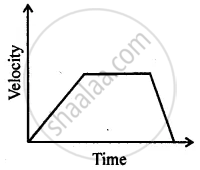Advertisements
Advertisements
प्रश्न
Derive the formula : v = u + at, where the symbols have usual meanings.
उत्तर
Consider a body has initial velocity (u) . Suppose it is subjected to a uniform acceleration (a) such that after time (t) its final velocity becomes (v). Now, from the definition of acceleration we know that:
Acceleration = `"Change in velocity"/"Time taken"`
The above expression can also be written as ,
`a = (v-u)/t`
On further simplification, we get the 1st equation of motion,
v = u + at
Where,
(a) - Acceleration
(v) - Final velocity
(u) - Initial velocity
(t) - Time taken
The equation v = u + at is called the first equation of motion and is used to calculate the velocity 'v' acquired by a body in time 't'.
APPEARS IN
संबंधित प्रश्न
A train starting from a railway station and moving with uniform acceleration attains a speed 40 km h−1 in 10 minutes. Find its acceleration.
Find the initial velocity of a car which is stopped in 10 seconds by applying brakes. The retardation due to brakes is 2.5 m/s2.
Describe the motion of a body which is accelerating at a constant rate of 10 m s–2. If the body starts from rest, how much distance will it cover in 2 s ?
A body starting from rest travels with uniform acceleration. If it travels 100 m in 5 s, what is the value of acceleration ?
A freely falling object travels 4.9 m in 1st second, 14.7 m in 2 nd second, 24.5 m in 3rd second, and so on. This data shows that the motion of a freely falling object is a case of :
Define velocity. State its unit.
Give one example of following motion :
Variable acceleration
Can you suggest a real-life example about the motion of a body from the following velocity – time graph?

How will the equations of motion for an object moving with a uniform velocity change?
An object starting from rest travels 20 m in the first 2 s and 160 m in the next 4 s. What will be the velocity after 7 s from the start?
